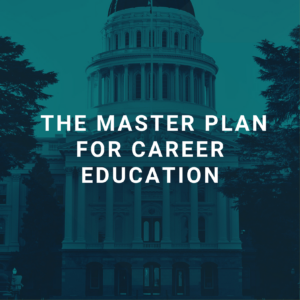
Post-secondary education and training is vital for fostering economic mobility among individuals and communities. The California EDGE Coalition firmly believes that by empowering individuals to acquire the skills demanded by the current labor market, California can thrive and prosper, leveraging the diverse talents and strengths of its population. While a significant proportion of Californians possess degrees, many still find themselves earning below a living wage. Hence, our priority should be on good-quality jobs, not just any jobs. The master plan for career education is poised to establish the cornerstone for California’s future workforce.
The following are recommendations and feedback on the Governor’s Master Plan for Career Education from the perspective of our diverse coalition including leaders in workforce development, education, labor, industry, and social justice.
Strengthening work-based learning. California should take the lead in establishing a comprehensive statewide vision and defining all aspects of the work-based learning continuum, encompassing pre-apprenticeships, internships, and youth apprenticeships. This effort should also involve clarifying the roles and responsibilities of employers in work-based learning and youth apprenticeship programs.
Strengthen career technical education and apprenticeship offerings. CTE offers students a practical learning environment that integrates academic knowledge with real-world workplace skills. Prioritizing policy reforms and investments to bolster CTE programs and enhance their accessibility, including through online platforms, is paramount. In tandem with CTE, the expansion of earn-and-learn pathways such as apprenticeships and pre-apprenticeship initiatives presents Californians with diverse career prospects across various trades and industries, fostering an inclusive workforce and avenues for economic advancement. Further, we endorse the Governor’s initiative to broaden career exploration opportunities and facilitate career progression for adults through postsecondary institutions, workforce agencies, and community-based organizations. Incorporating labor-management training partnerships into this endeavor would further enrich its scope and efficacy. Strengthening CTE and apprenticeship pathways for adult learners, opportunity youth, and workers is pivotal in expanding both short and long-term training options leading to high-quality, industry-recognized credentials and certifications.
Empowering opportunity youth. ACR 16 (Mike Fong, 2023) underscores the critical need to forge pathways to success for California’s opportunity youth while advocating for the establishment of a comprehensive statewide strategy aimed at mitigating economic disparities. This entails securing stable resources for education and workforce training; expansion of earn-and-learn opportunities; increasing dual enrollment access; ensuring opportunity youth data are included in the Cradle-to-Career Data System; expanding social safety net investments to address basic needs and removing barriers to accessing financial aid programs. The master plan has an opportunity to incorporate policies and strategies that will open the door for economic mobility for California’s youth. Therefore, the master plan should include ACR 16 strategic goals to best support opportunity youth.
Increase flexible learning approaches like adult dual enrollment, credit for prior learning, and competency-based education opportunities. Flexible learning approaches are tailored to individual learning needs and prior experiences, accessible anytime, delivered through nontraditional methods, formally recognizing both traditional and nontraditional learning, and adaptable to economic shifts. The plan must include strategies that will increase adult dual enrollment access. Adult dual enrollment programs expedite learners’ educational and training pursuits, enhance affordability, and accelerate the attainment of credentials necessary for in-demand jobs sought by industries. Additionally, credit for prior learning grants credit for experiences outside traditional classrooms, while competency-based education enables learners to progress at their own pace, earning credit and credentials based on demonstrated competence. Flexible learning approaches like these increase the likelihood of adults efficiently upskilling throughout their lives.
Increase collaboration between industry and education entities. Education and training institutions, in collaboration with labor-management partnerships, must forge strong ties with industry to guarantee that students are adequately prepared for the workforce and receive the necessary support to obtain stable, family-sustaining employment upon program completion. Moreover, the state should play a pivotal role in alleviating logistical, regulatory, and financial obstacles hindering employer engagement. Streamlining administrative requirements for employers across various funding channels utilized for dual education is essential to promote seamless participation and maximize the effectiveness of these initiatives.
Increase access for underserved communities. The plan must detail how the community will be engaged and informed about accessing workforce development, education, and training opportunities. It is important to reach people where they are, like in school settings to connect with parents. It is also vital to ensure that programs and opportunities are designed to support communities of color, including undocumented workers. This means promoting opportunities in languages they understand and with cultural sensitivity, especially for English language learners. Additionally, resources should be available for those seeking information about Individual Taxpayer Identification Numbers (ITIN) or work permits.
Securing a safety net for students & workers. We commend the administration for striving to enhance access to public benefits, aiming to support learners in affording education and training. Balancing education and employment goals becomes difficult for students grappling with challenges like childcare, transportation, housing, and food insecurity. Equipping students and workers with resources to meet their basic needs, alongside increased access to student financial aid, strengthens their ability to participate in and successfully complete programs leading to employment opportunities. We propose the implementation of integrated benefit application systems. For instance, a post-secondary education application could automatically assess eligibility for public benefits. Integrating social benefit programs into educational institutions, leveraging existing investments in community schools and basic needs centers, can effectively address the holistic needs of students. To tackle the issue of total cost of attendance, we suggest removing GPA requirements from the Cal Grant program for community college students. Presently, requiring proof of high school GPA poses a barrier for adult learners and opportunity youth who have been disconnected from educational and workforce systems. This requirement often dissuades potential applicants, despite GPA not being a reliable indicator of success in community college. By prioritizing safety net investments, we can empower underserved students and workers to achieve their educational and training aspirations.
Strengthen statewide data. California’s Cradle-to-Career Data System will consolidate education, workforce, and human services data statewide, providing decision-makers and the public with a holistic understanding of pathways to quality employment. To maintain its effectiveness, we advise the state to continue investing in the data system and adapt it as labor markets evolve and new data points become necessary to address gaps and disparities in education and workforce systems. Leveraging comprehensive data will inform program development, implementation, and accountability, leading to continuous improvement in outcomes for students and employers.
In addition to our recommendations, we have the following concerns:
Creating new regional bodies and incentive funding based on common measures. We have reservations regarding the establishment of additional regional bodies and the distribution of funds through such entities, absent a thorough examination of the current regional bodies throughout California. Before considering the establishment of new regional bodies, we suggest that the state undertake a comprehensive landscape analysis of existing bodies, assessing their roles, effectiveness, and impact. Given the many regional “tables” already in existence, consideration of potential consolidation or improved collaboration among existing regional entities should be considered. The workforce development boards already have mandates to plan for and integrate consideration of the needs of employers, education, and training providers at a regional level. Similarly, community colleges rely on long-standing consortia for coordination of CTE programming at the regional level. The regional K16 Educational Collaboratives along with myriad regional collective impact efforts also aim to coordinate across educational and workforce initiatives.
Similarly, it would be timely to assess the processes for allocation of funds through these and other regional bodies. For instance, a portion of funds designated for the Strong Workforce Initiative flows through regional consortia, with allocations to each region contingent upon performance across various metrics. Has there been a systematic evaluation of the efficacy of this distribution model? These entities were not originally designed nor mandated to manage funding, whereas colleges are held directly accountable for their student outcomes. However, the colleges find themselves in a precarious position, unable to reliably forecast funding from year to year due to their reliance on regional outcome averages, which are susceptible to many external factors. This volatility in funding undermines the colleges’ ability to strategize and make sustained improvements over time. In addition, much of the regional Strong Workforce funding (both K14 and K12) as well as the Career Technical Education Incentive Grant (CTEIG) funding is distributed via competitive grants. While this approach appears to have successfully incentivized and fostered new programming and innovations, the competitive process adds to the workload of districts and colleges seeking to build, sustain, and evolve quality CTE pathways. And it may privilege districts with more sophisticated or dedicated grant writing capacity.
Multiple studies have raised questions about the effectiveness of performance-based and incentive funding. Recently, a comprehensive study concluded that the critical factors are the level and predictability of funding. According to a new peer-reviewed article, state funding mechanisms for higher education have little impact on enrollment or student outcomes at public institutions. Instead, researchers argue that the size of appropriations and the clarity and consistency of allocation formulas play a more significant role. Despite their increasing popularity, incentive and hybrid models seem to have minimal, if any, desired effects. There’s a prevailing notion that our funding prioritizes efficiency over equity. However, if we were to intentionally prioritize equity in our funding approach, it could potentially lead to both increased effectiveness and efficiency. (see Funding Models Don’t Drive Performance, Study Finds, Inside Higher Ed, March 15, 2024 )
We extend our appreciation to Governor Newsom for his leadership and for considering EDGE’s perspective as the Master Plan is developed. EDGE looks forward to collaborating with our partners, the Legislature, and the Governor to advance a Master Plan that advances economic mobility for Californians historically left out of our state’s prosperity.
For questions, please contact Anna Alvarado, Policy Director, at aalvarado@caedge.org
